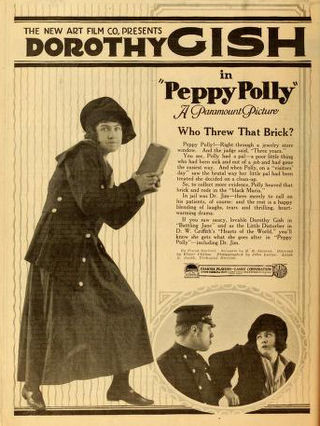
Richard Semler Barthelmess was an American film actor, principally of the Hollywood silent era. He starred opposite Lillian Gish in D. W. Griffith's Broken Blossoms (1919) and Way Down East (1920) and was among the founders of the Academy of Motion Picture Arts and Sciences in 1927. The following year, he was nominated for the Academy Award for Best Actor for two films: The Patent Leather Kid and The Noose.

Broken Blossoms or The Yellow Man and the Girl, often referred to simply as Broken Blossoms, is a 1919 American silent drama film directed by D. W. Griffith. It was distributed by United Artists and premiered on May 13, 1919. It stars Lillian Gish, Richard Barthelmess, and Donald Crisp, and tells the story of young girl, Lucy Burrows, who is abused by her alcoholic prizefighting father, Battling Burrows, and meets Cheng Huan, a kind-hearted Chinese man who falls in love with her. It was the first film distributed by United Artists. It is based on Thomas Burke's short story "The Chink and the Child" from the 1916 collection Limehouse Nights. In 1996, Broken Blossoms was included in the annual selection of 25 motion pictures to be added to the National Film Registry of the Library of Congress.

Lillian Diana Gish was an American actress. Her film-acting career spanned 75 years, from 1912, in silent film shorts, to 1987. Gish was called the "First Lady of American Cinema", and is credited with pioneering fundamental film performance techniques. In 1999, the American Film Institute ranked Gish as the 17th greatest female movie star of Classic Hollywood cinema.

Dorothy Elizabeth Gish was an American stage and screen actress. Dorothy and her older sister Lillian Gish were major movie stars of the silent era. Dorothy also had great success on the stage, and was inducted into the American Theater Hall of Fame. Dorothy Gish was noted as a fine comedian, and many of her films were comedies.

Sarah Blanche Sweet was an American silent film actress who began her career in the early days of the motion picture film industry.

Robert Emmett Harron was an American motion picture actor of the early silent film era. Although he acted in over 200 films, he is possibly best recalled for his roles in the D.W. Griffith directed films The Birth of a Nation (1915) and Intolerance (1916).

Carol Dempster was an American film actress of the silent film era. She appeared in films from 1916 to 1926, working with D. W. Griffith extensively.

Orphans of the Storm is a 1921 American silent drama film by D. W. Griffith set in late-18th-century France, before and during the French Revolution.

William Burr McIntosh was an American lecturer, photographer, film studio owner, silent film actor, author, publisher of TheBurr McIntosh Monthly, reporter and a pioneer in the early film and radio business.

The Painted Lady is a 1912 American short drama film directed by D. W. Griffith and starring Blanche Sweet. A print of the film survives.

The Greatest Thing in Life is a 1918 American silent drama film about World War I, directed by D. W. Griffith and starring Lillian Gish, Robert Harron, and David Butler. The film is now considered lost as no prints are known to exist.

True Heart Susie is a 1919 American drama film directed by D. W. Griffith and starring Lillian Gish. A print of the film survives in the film archive of the British Film Institute. The film has seen several VHS releases as well as a DVD issue.

Charlotte Blair Parker was an American playwright and actress in the late 19th and early 20th centuries. She began her theatrical career as an actress, eventually playing opposite John Edward McCullough, Mary Anderson, and Dion Boucicault. Writing under the pen name Lottie Blair Parker, she wrote about a dozen produced plays but is remembered most for three popular stage plays produced between 1897 and 1906: Way Down East, Under Southern Skies and The Redemption of David Corson. Of the three, Way Down East, produced in 1898, was the most successful, proving to be one of the most popular American plays of its time, steadily performed for two decades.

Clarine E. Seymour was an American silent film actress.

Remodeling Her Husband is a 1920 American silent comedy film that marked the only time Lillian Gish directed a film.

Mary Hay Caldwell was an American dancer, musical comedy and silent screen actress, playwright, and former Ziegfeld girl.

Peppy Polly is a lost 1919 American silent drama film directed by Elmer Clifton and starring Dorothy Gish. D. W. Griffith produced, as he did for several of Gish's films.
Way Down East is a 1935 American romantic drama film directed by Henry King and starring Rochelle Hudson, Henry Fonda, Slim Summerville, Margaret Hamilton, Andy Devine and Spring Byington. It was released by 20th Century Fox and produced by Fox Film Corporation.

Anna Karenina is a 1920 German silent historical film, directed by Frederic Zelnik and starring Lya Mara, Johannes Riemann, and Heinrich Peer. It is an adaptation of Leo Tolstoy's 1877 novel Anna Karenina. It premiered at the Marmorhaus in Berlin.





















